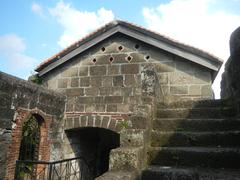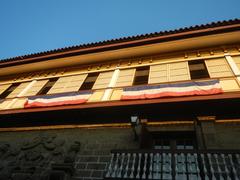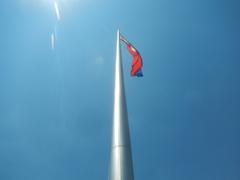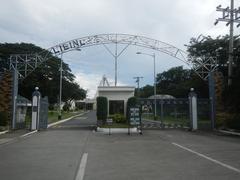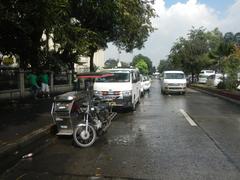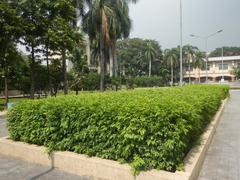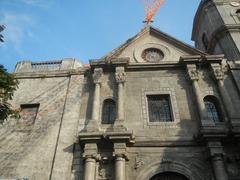Visiting Jones Bridge: Hours, Tickets, and Historical Sites in Taguig, Philippines
Date: 23/07/2024
Introduction
Jones Bridge, located in Taguig, Philippines, is a historical and architectural marvel that stands as a testament to the resilience and rich cultural heritage of the Filipino people. Originally constructed during the American colonial period and named after William Atkinson Jones, an American legislator who championed Philippine autonomy, the bridge has become a symbol of national pride (source) (source). The bridge’s neoclassical and Beaux-Arts design elements, including ornate lamp posts, balustrades, and statues, make it a significant cultural landmark and a favorite spot for photographers and history enthusiasts (source). Over the decades, Jones Bridge has undergone several reconstructions, particularly after the extensive damage it suffered during World War II, and has recently been restored to its former glory. This guide provides a comprehensive overview of Jones Bridge’s historical context, architectural significance, and practical visitor information, ensuring that every visitor can fully appreciate this iconic structure and its surroundings.
Table of Contents
- [Introduction](#introductionintroduction)
- [Early Conception and Construction](#early-conception-and-constructionearly-conception-and-construction)
- [World War II and Reconstruction](#world-war-ii-and-reconstructionworld-war-ii-and-reconstruction)
- [Restoration Efforts](#restoration-effortsrestoration-efforts)
- [Cultural Significance](#cultural-significancecultural-significance)
- [Modern-Day Relevance](#modern-day-relevancemodern-day-relevance)
- [Visitor Information](#visitor-informationvisitor-information)
- [Visiting Hours](#visiting-hoursvisiting-hours)
- [Tickets](#ticketstickets)
- [Travel Tips](#travel-tipstravel-tips)
- [Nearby Attractions](#nearby-attractionsnearby-attractions)
- [Accessibility](#accessibilityaccessibility)
- [FAQ](#faqfaq)
- [Future Prospects](#future-prospectsfuture-prospects)
- [Visitor Tips](#visitor-tipsvisitor-tips)
- [Best Time to Visit](#best-time-to-visitbest-time-to-visit)
- [Getting There](#getting-theregetting-there)
- [What to Wear](#what-to-wearwhat-to-wear)
- [Safety Tips](#safety-tipssafety-tips)
- [Photography Tips](#photography-tipsphotography-tips)
- [Nearby Attractions](#nearby-attractionsnearby-attractions)
- [Dining Options](#dining-optionsdining-options)
- [Accessibility](#accessibilityaccessibility)
- [Local Etiquette](#local-etiquettelocal-etiquette)
- [Useful Apps](#useful-appsuseful-apps)
- [Emergency Contacts](#emergency-contactsemergency-contacts)
- [Frequently Asked Questions (FAQs)](#frequently-asked-questions-faqsfrequently-asked-questions-faqs)
- [Conclusion](#conclusionconclusion)
Early Conception and Construction
Jones Bridge, located in Manila, Philippines, dates back to the early 20th century. Named after William Atkinson Jones, the American legislator responsible for the Philippine Autonomy Act of 1916, the bridge replaced the Puente de España, which had been damaged by earthquakes and floods. Designed by prominent Filipino architect Juan M. Arellano, construction began in 1916 and was completed in 1920. The bridge’s neoclassical design included ornate balustrades, statues, and lampposts, making it a vital artery for both vehicular and pedestrian traffic.
World War II and Reconstruction
Like many structures in Manila, Jones Bridge suffered extensive damage during World War II. Bombed by Japanese forces in 1942, it was partially destroyed. Post-war reconstruction in 1946 adopted a more utilitarian design, stripping away much of its original neoclassical beauty. Despite this, the bridge remained a crucial link between the northern and southern parts of Manila.
Restoration Efforts
Recent years have seen concerted efforts to restore Jones Bridge to its former glory. In 2019, under Mayor Isko Moreno’s leadership, the City of Manila initiated a restoration project to reincorporate neoclassical elements. The project included replica statues, ornate lampposts, and balustrades, closely resembling Juan M. Arellano’s original design. Completed in 2020, the restoration has been praised for its historical accuracy and attention to detail.
Cultural Significance
Jones Bridge holds a special place in the hearts of many Filipinos, symbolizing the country’s resilience and ability to rebuild and restore its heritage. Featured in numerous films, television shows, and photographs, the bridge is an enduring icon of Manila. Its restoration has renewed interest in Manila’s architectural heritage and inspired similar efforts for other historical structures.
Modern-Day Relevance
Today, Jones Bridge continues to be a vital part of Manila’s transportation network. It accommodates both vehicular and pedestrian traffic and has become a popular spot for tourists and locals alike. The bridge’s aesthetic appeal has spurred economic activity and revitalized the local community, making it a popular destination for photographers, artists, and history enthusiasts.
Visitor Information
Visiting Hours
Jones Bridge is open to the public 24/7. The best time to visit is during the early morning or late afternoon when the lighting is ideal for photography.
Tickets
There is no entrance fee to visit Jones Bridge. It is freely accessible to everyone.
Travel Tips
- Wear comfortable shoes to explore the length of the bridge and its surroundings.
- Consider visiting during weekdays to avoid the weekend crowds.
Nearby Attractions
After visiting Jones Bridge, explore nearby historical sites such as Intramuros, Fort Santiago, and the Manila Cathedral. These attractions are within walking distance or a short ride away.
Accessibility
The bridge is accessible to both pedestrians and vehicles. Ramps are available for wheelchair users.
FAQ
Q: What are the best times to visit Jones Bridge?
A: Early morning and late afternoon are ideal times for visiting, as the lighting is perfect for photography.
Q: Is there an entrance fee to visit Jones Bridge?
A: No, visiting Jones Bridge is free of charge.
Q: Are there any nearby attractions to visit after Jones Bridge?
A: Yes, you can visit Intramuros, Fort Santiago, and the Manila Cathedral, which are all nearby.
Q: Is Jones Bridge accessible for wheelchair users?
A: Yes, the bridge has ramps available for wheelchair access.
Future Prospects
The City of Manila has proposed further enhancements around Jones Bridge, including pedestrian-friendly zones, green spaces, and cultural hubs. These initiatives aim to create a more vibrant and livable urban environment while preserving the historical and cultural significance of Jones Bridge.
Visitor Tips
Best Time to Visit
The best time to visit Jones Bridge is during the dry season, from November to April.
Getting There
- By Car: Use navigation apps like Google Maps or Waze.
- Public Transport: Accessible via jeepneys, buses, and taxis.
- Ride-Hailing Services: Apps like Grab are widely used.
What to Wear
Lightweight and breathable clothing is recommended. Comfortable walking shoes are essential, and don’t forget a hat, sunglasses, and sunscreen.
Safety Tips
- Stay Hydrated: Drink plenty of water.
- Personal Belongings: Keep an eye on your belongings.
- Local Customs: Respect local customs and traditions.
Photography Tips
- Golden Hour: Visit during early morning or late afternoon for the best lighting.
- Angles and Perspectives: Experiment with different angles.
- Night Photography: The bridge is beautifully illuminated at night.
Nearby Attractions
- Bonifacio Global City (BGC): A modern business district with shopping malls, restaurants, and parks.
- Venice Grand Canal Mall: Offers gondola rides, shopping, and dining options.
- The Mind Museum: An interactive science museum in BGC.
Dining Options
- Local Cuisine: Try traditional Filipino dishes at restaurants like Manam or Locavore.
- International Cuisine: Visit restaurants like Wildflour Café + Bakery or Din Tai Fung.
- Street Food: Explore the local street food scene for a budget-friendly experience.
Accessibility
Jones Bridge is accessible to visitors with disabilities. Check specific accessibility features in advance.
Local Etiquette
- Greetings: Filipinos are friendly and polite. A simple “hello” or “good day” (magandang araw) is appreciated.
- Tipping: A 10% tip is customary in restaurants if service is not included.
- Respect: Show respect for local customs and traditions.
Useful Apps
- Google Maps: For navigation.
- Grab: For ride-hailing services.
- Klook: For booking tours and activities.
- XE Currency: For currency conversion.
Emergency Contacts
- Police: Dial 117 or 911
- Fire Department: Dial 160
- Medical Emergency: Dial 911 or contact the nearest hospital
Frequently Asked Questions (FAQs)
- What are the visiting hours for Jones Bridge? Jones Bridge is accessible 24/7.
- Is there an entrance fee for Jones Bridge? No, there is no entrance fee.
- Are there guided tours available? While there are no official guided tours specifically for Jones Bridge, local tour operators offer comprehensive tours of Taguig.
- What is the best time for photography at Jones Bridge? Early morning or late afternoon for golden hour shots; nighttime for illuminated views.
Conclusion
Jones Bridge is more than just a bridge—it’s a symbol of Manila’s enduring spirit and rich cultural heritage. Whether you’re a local or a tourist, a visit to Jones Bridge offers a unique glimpse into the history and beauty of Manila. Don’t miss out on this iconic landmark, and be sure to explore the surrounding historical sites to fully appreciate the city’s vibrant past and present (source) (source). The bridge’s role in connecting the bustling districts of Binondo and Ermita, its cultural significance, and its impact on local tourism and economy make it a vital part of Manila’s urban landscape. By following the provided tips and utilizing the information in this guide, visitors can ensure a safe, enjoyable, and memorable visit.

